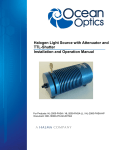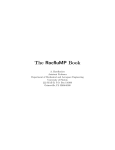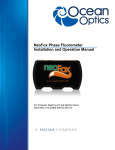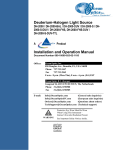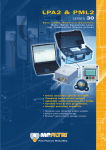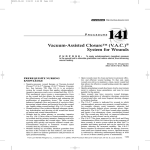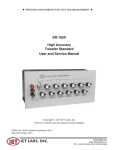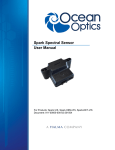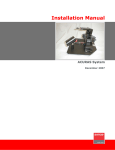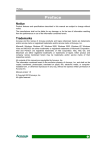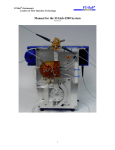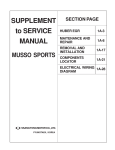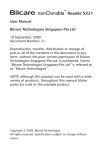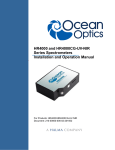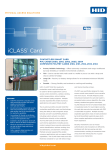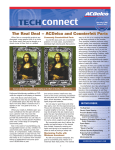Download SERS User Manual
Transcript
OCEAN OPTICS SERS User Manual For Products: RAM-SERS-AU-X Document: RAM-SERS-AUX-07-201410 AMERICAS & WORLD HEADQUARTERS Phone: (+1) 727-733-2447 Fax: (+1) 727-733-3962 Sales: Orders: Support: [email protected] [email protected] [email protected] EUROPE, MIDDLE EAST & AFRICA Phone: (+31) 26-319-0500 Fax: (+31) 26-319-0505 Email: [email protected] Germany : (+49) 711-341696-0 UK : (+44) 1865-811118 France : (+33) 442-386-588 Ocean Optics, Inc. 830 Douglas Ave. Dunedin, FL 34698 USA Manufacturing & Logistics 4301 Metric Dr. Winter Park, FL 32792 USA Sales & Support Geograaf 24 6921 EW Duiven The Netherlands Manufacturing & Logistics Maybachstrasse 11 73760 Ostfildern Germany ASIA Phone: +86 21-6295-6600 Fax: +86 21-6295-6708 Email: [email protected] Japan & Korea: (+82) 10-8514-3797 Ocean Optics Asia 666 Gubei Road Kirin Tower Suite 601B Changning District Shanghai PRC, 200336 Copyright © 2014 Ocean Optics, Inc. All rights reserved. No part of this publication may be reproduced, stored in a retrieval system, or transmitted, by any means, electronic, mechanical, photocopying, recording, or otherwise, without written permission from Ocean Optics, Inc. This manual is part of an order and subject to the condition that it shall not, by way of trade or otherwise, be lent, re-sold, hired out or otherwise circulated without the prior consent of Ocean Optics, Inc. in any form of binding or cover other than that in which it is published. Trademarks All products and services herein are the trademarks, service marks, registered trademarks or registered service marks of their respective owners. Limit of Liability Every effort has been made to make this manual as complete and as accurate as possible, but no warranty or fitness is implied. The information provided is on an “as is” basis. Ocean Optics, Inc. shall have neither liability nor responsibility to any person or entity with respect to any loss or damages arising from the information contained in this manual. Table of Contents About This Manual......................................................................................................... iii Document Purpose and Intended Audience.............................................................................. iii Document Summary .................................................................................................................. iii Product-Related Documentation ............................................................................................... iii Chapter 1: Introduction ..................................................................... 1 What Is SERS? ............................................................................................................. 1 Typical Applications of SERS ........................................................................................ 1 What Is Raman Spectroscopy? ..................................................................................... 2 Ocean Optics’ SERS Key Features ............................................................................... 2 Key Specifications ......................................................................................................... 3 Diagram ......................................................................................................................... 4 Package Contents ......................................................................................................... 4 Chapter 2: Using SERS ..................................................................... 5 Usage Notes.................................................................................................................. 5 Standard Measurement Protocol ................................................................................... 5 Best Practices ............................................................................................................................ 6 Storage.......................................................................................................................... 6 Frequently Asked Questions .......................................................................................... 7 Appendix A: Specifications............................................................... 9 Overview ....................................................................................................................... 9 Performance Specifications ........................................................................................... 10 Description of Tests Performed ................................................................................................. 10 Peak Intensity Ratio Repeatability ............................................................................................. 11 BPE ....................................................................................................................................... 11 TNT ....................................................................................................................................... 13 Raw Peak Intensity Reproducibility ........................................................................................... 14 Signal to Noise Ratio ................................................................................................................. 14 Extent of Enhancement ............................................................................................................. 15 Limits of Detection Across Optical Benches................................................................... 17 RAM-SERS-AUX-07-201410 i Table of Contents QE Pro ....................................................................................................................................... 17 Maya Series ............................................................................................................................... 18 USB4000 ................................................................................................................................... 18 IDRaman mini ............................................................................................................................ 19 IDRaman reader ........................................................................................................................ 20 Expected Behavior with Variation in Laser Power .......................................................... 20 Index ................................................................................................... 23 ii RAM-SERS-AUX-07-201410 About This Manual Document Purpose and Intended Audience This document provides instructions for using Ocean Optics’ Surface Enhanced Raman Substrates (SERS). Document Summary Chapter Description Chapter 1: Introduction Contains descriptive information about SERS and Raman spectroscopy. Chapter 2: Using SERS Provides use instructions. Appendix A: Specifications Contains technical specifications for the SERS product. Product-Related Documentation You can access documentation for Ocean Optics products by visiting our website at http://www.oceanoptics.com. Select Support → Technical Documents, then choose the appropriate document from the available drop-down lists. Warranty Ocean Optics SERS is protected by a limited warranty against faulty manufacturing of goods. This warranty will not cover misuse or misadventure. Users are reminded that SERS is a technique that while suitable for many samples will not work for all. Ocean Optics takes no responsibility for unsuccessful use or application of the SERS product. This also applies to any customized or OEM applications of Ocean Optics’ SERS substrates. A 3-Year Warranty covers Ocean Optics miniature fiber optic spectrometers, light sources and sampling accessories – regardless of the application – from manufacturing defects. It also covers fibers and probes for a full 12 months. All OEM hardware is covered by a 12 month warranty. For more information about Ocean Optics Warranties, please see: http://www.oceanoptics.com/warranty.asp. RAM-SERS-AUX-07-201410 iii About This Manual iv RAM-SERS-AUX-07-201410 Chapter 1 Introduction What Is SERS? In Surface Enhanced Raman Spectroscopy (SERS), analytes (your sample) are absorbed onto a noble metal (in this case either Au or Ag nanoparticles) surface prior to analysis in order to potentially enhance the Raman signal. By introducing the sample into a 3-Dimensional matrix, within which gold or silver nanoparticles have been deposited, and exciting with an excitation laser, the interaction between the SERS substrate and the sample, plus the excitation energy of the laser creates a plasmon resonant effect that can potentially amplify the Raman effect by many orders of magnitude. SERS enables ppb and even ppt-level detection of chemical and biological materials quickly and easily in the field. It also has many applications for pharmaceuticals, explosives, and tags for anti-counterfeiting. SERS substrates have traditionally been fabricated using expensive lithography techniques and are not reusable, making cost a deterrent to use in mainstream applications. Ocean Optics’ substrates offer equivalent or better performance than the competitor SERS products at a fraction of the price by using industrial deposition techniques to precisely deposit special nanoparticle ink onto a flexible substrate. One of the advantages of our SERS technology is that it is compatible with the Ocean Optics’ full range of Raman spectrometers, meaning that portable measurement is possible with our IDRaman mini and IDRaman reader. Though peak intensity varies from substrate to substrate, peak ratio repeatability is very good, typically 5% or less. This provides for the substrates to be used both quantitatively and for simple identification purposes. SERS sounds like the dream technique, so what’s the catch? Not all samples are SERS active and users should be aware that SERS will not work out of the box for every sample. Because of our special method for manufacturing we can work with you to develop customized recipes for specific analytes, please contact us for more information. SERS can also shift the peaks relative to standard Raman spectra, i.e., a sample measured at high concentration without SERS may have different peak shifts when looked at with SERS. However, any change is consistent and so, therefore, is easily characterized. It does mean, however, that users requiring library matching should develop the library with SERS rather than adopting existing libraries for SERS applications. Typical Applications of SERS • • Detection of Explosives: Explosives are clearly a big security threat. Being able to identify trace levels allows us to better screen for threats at security checkpoints or on the battlefield. Detection of Narcotics: Fast identification of Drugs in the field is a real boon for those combating drug related crime. Often only small residues of a sample can be collected from a crime scene. SERS also opens up a potential route for fast roadside drug screening using saliva samples. RAM-SERS-AUX-07-201410 1 2: Using SERS • • • Food Safety: Certain additives such as Melamine found in milk powder or green malachite can be extremely harmful even at very low concentrations. Using SERS, we can qualify and quantify the level of dangerous trace elements in our food supply chain. Anti-counterfeit tags: High value products that are subject to duties & taxes are often the target of piracy and fraud. Petrol is one example. By adding a small amount of a SERS active taggant we can use this as an indicator of authenticity. Biological Research: Can be used to identify and characterize biological samples including identifying proteins, DNA and bacteria. What Is Raman Spectroscopy? Gold nano-particles were mentioned above, and Raman spectroscopy really is like panning for gold! A wealth of information is there, if you can just sift through the rock, dirt, and sand obscuring it. The art to finding the gold in Raman spectra is the instrumentation, which must collect as many photons as possible while rejecting scattered laser light efficiently. Raman spectra are generated when an incident photon from an excitation source interacts with a sample and rather than being simply (Raleigh) scattered it communes with the vibrational energy of the sample molecule and is reflected as Raman (stokes-shifted) light. By filtering out the background and detecting just the shifted light we obtain a fingerprint spectra, packed with information about the atoms and structure of the molecule. A good way to visualize the Raman effect is to imagine a ball bearing being dropped onto a drum. The drum starts to vibrate at its own frequency, and the ball bearing bounces off with slightly less energy (analogous to Stokes radiation). If the drum is already vibrating and the ball bearing hits at just the right time, the drum acts like a catapult to give energy to the ball bearing and it bounces off with even more energy (analogous to anti-Stokes radiation). The energy difference before and after the ball bearing strikes the drum provides information about the vibrational mode of the drum. [Fundamentals of Molecular Spectroscopy, Banwell and McCash, John Wiley & Sons, Inc., New York, 1988] Ocean Optics’ SERS Key Features • • • • • 2 High sensitivity. Substrates deliver great results and have demonstrated superior sensitivity for a range of analytes when tested against competitor substrates, all for an unbeatable price. Great stability. Highly stable substrates require no special handling and can be stored at room temperature Reliable reproducibility. Highly reproducible and easily scaled manufacturing methods enable sensitive measurements at an affordable price. Our testing has shown reliable peak ratio reproducibility within 5%. Customization. Unique production techniques can be tailored to impart specificity to particular analytes (on demand) and custom form factors such as swabs and coatings Easy to use. For great flexibility, substrates work reliably with the complete range of Ocean Optics Raman instruments. Simply drop your analyte onto the slide and use with a 785nm Raman setup. RAM-SERS-AUX-07-201410 2: Using SERS Key Specifications Specification Value SERS Slide Dimensions 25.4 x 76.2 x 1 mm SERS Active Area 5.5 mm diameter circle SERS Active Chemistry Gold (Au) Nanoparticles Slide Material Borosilicate Glass Raman Excitation Wavelength 785 nm Material Why Do I Want to Detect Race Levels? LOD with QE-Pro* BPE BPE can be used as a taggant in fuel as well as in biological samples 1 ppb TNT The threat of terrorism means the need for quick screening for trace levels of explosives is greater than ever 227 ppm Melamine Poisonous to humans, especially babies and children at very low levels (<1 ppm) 12 ppm *Please note that the LOD will depend on the sample and spectrometer used and that these are provided as guidelines only. RAM-SERS-AUX-07-201410 3 2: Using SERS Diagram Package Contents Each pack of RAM-SERS-AU-5 comes with 5 individual substrates. Simply remove from the packaging and you’re ready to get going. 4 RAM-SERS-AUX-07-201410 Chapter 2 Using SERS Usage Notes • • • • Use gloves during handling and ensure you are working in a clean environment. Never touch the active SERS circle. As these are highly sensitive, any contamination has the potential to show up on your analytical spectra. Do not touch or apply pressure to the active SERS area as this may damage the nano-paticle structures. Just one small drop of your sample dissolved in solvent needs to be applied, usually up to 10 µL. Using a known reference solution is a good way to optimize your measurement and software settings. These slides are one-time use, and should be discarded after the spectrum has been acquired. Reuse is not possible as once the sample has been absorbed onto the active area it is not possible to cleanse/remove it. Solvent-Compatible Substrate and Adhesive Some competitor products use plastics as the base material, which greatly limits the types of carrier solvents that can be used with those SERS products. Our use of optical-grade borosilicate glass allows for even the harshest of solvents to be used on the SERS chemistry. The adhesive that holds the chemistry to the plate is a high-performance silicone-based adhesive compatible with a huge range of solvents. Standard Measurement Protocol Use clean gloves at all times when handling the SERS substrates. Remember SERS amplifies the Raman signal from trace levels and even small amounts of interfering samples may affect your measurement. The measurement parameters can greatly affect the overall performance of the SERS substrate and these should be optimized carefully. Once optimized, this setup can be used for subsequent measurements with the same spectrometer type, laser and integration time enabling consistent and comparative data to be collected (see Best Practices). ► Procedure 1. Open the foil shipping bag. The substrates are contained within the plastic slide holder for their protection. RAM-SERS-AUX-07-201410 5 2: Using SERS 2. Do not to touch the SERS active region on the slide. Also do not to allow the active area to come into contact with any other surface. This will help to avoid contamination. 3. It is important to keep the SERS substrates clean. Care should be taken in high humidity atmospheres as this may increase the chances of a non-analyte molecule being absorbed onto the substrate. Note also that the substrates should not be exposed to vapors or other potential contaminants that can adsorb onto the surface. 4. Introduce the analyte of interest directly onto the active area. We recommend drop casting or micro pipetting 12.5µL of testing analyte directing onto the SERS active area. If pipetting, your sample should be prepared using an appropriate solvent. 5. After the analyte has been deposited onto the SERS surface the measurement can be obtained immediately. You may observe some time-dependent effects as the solvent evaporates. The rate of evaporation can be accelerated by the application of the laser energy. Allow the response to stabilize before recording the measurement results. Slides should be disposed in standard glass waste containers. Please note that disposal protocol will be analyte dependent. Be sure to use an appropriate disposal method. Best Practices To ensure the best signal enhancement from the SERS substrate, we recommend that you observe the following parameters: • • • Focal distance -- Ensure that the laser is focused on the sample and that the correct focal distance for the Raman system/probe is used. An X-Y stage can be used to adjust the focal distance to ensure that maximum response from the substrate is achieved. Once you have determined an appropriate distance you can fix the stage in position to maintain that focus for repeated measurements. Laser power -- The Raman response will also depend on the laser power. Too little and there will be no discernable signal, too much and you may damage the sample. The correct power depends on the sample, but for many of the samples we have tested with 785 nm systems we have found that 50mW – 100mW is appropriate. Integration time -- As with the laser power, the integration time will depend on the measurement sample and conditions, the requirements of the application and the spectrometer used. Increasing integration time allows the collection of more Raman photons, thus increasing the signal. However, it can also increase background or fluorescence effects. Storage Each bag contains a box of 5 SERS substrates and a desiccant pouch to minimise humidity. While Ocean Optics SERS can be stored in normal conditions, we recommend the following to maximise shelf life and performance: • • 6 Open the bag only when you are ready to use the first substrate. Ideal storage temperature is room temperature (15-25°C). If not using all 5 substrates within 24 hours, keep the remaining substrates in a dry environment such as a desiccator. A moistureresistant Ziploc bag with the included desiccant pouch is also suitable. RAM-SERS-AUX-07-201410 2: Using SERS • • Use these in a clean environment and wear gloves during handling, ensuring never to touch the active SERS circle. As the SERS slides are highly sensitive, any contamination has the potential to show up in your results. Use all substrates before the published use by date. The products may continue to show results after this time but the sensitivity will be diminished. Frequently Asked Questions What Kind of Raman Equipment do I need to use with SERS substrates? Ocean Optics SERS substrates are designed to work with all Ocean Optics Raman equipment. This includes a range of modular solutions where a spectrometer can be combined with a modular laser and a probe. It also includes a range of integrated solutions for handheld, benchtop and microscope applications. How do I get my sample onto the active area of the SERS substrate? If not already in solution, we recommend preparing your sample in solution with an appropriate solvent. SERS will work with dry powders or other trace amounts of solid samples but solution will generate the most reliable results as it allows the analyte to absorbed uniformly both across and the through the SERS active area. How do I know if my sample will be SERS active? You don’t! It’s difficult to know ahead of time whether your sample will work with standard SERS. It all depends on the relationship between the gold nano particles and your analyte. By adjusting the size and density of the nano-particles it is possible to tune SERS to work better/worse for particular analytes. It is also possible to dope the substrate with linking molecules that help bind the analyte to the nano-particles. This can be effective for It is important to recall, however, that SERS will not make a non-active Raman sample active. This means no metals, salts or molecules which do not meet the rules of symmetry that make a molecule Raman active. Which excitation laser wavelength should I use for gold SERS? While there is no fixed rule, in general gold based SERS have shown best results using 785nm lasers. Many applications of SERS mention silver, do you have silver SERS and which laser wavelength should I use? As of late 2014 we continue to work on producing a commercial silver substrate to offer alongside our gold product. At the moment we are no satisfied with the stability of our substrates to offer them as a standard product but we continue to work on their development. If you have a particular application that you think requires silver, get in touch. While gold is generally used with 785 nm excitation lasers, silver generally uses 532 nm. However, like with the gold – there is no firm rule here. RAM-SERS-AUX-07-201410 7 2: Using SERS What does “…particles will oxidize and this causes a reduction in the performance of the substrate as it ages,” mean? Do they just lose effectiveness (sensitivity)? How can I tell when this has happened? All pure metals will oxidize eventually – but some are worse than others while others such as gold are quite slow. The oxide layer is very stable (molecules like settling in that state). This tough oxide layer on top of your nanoparticles destroys the resonance SERS effect because the analyte cannot interact with the pure metal nano-structures.You can’t tell by looking at it which is why we have a use by date on the slide. Is there any way to slow the aging process caused by oxidation? We continue to investigate ways to improve lifetime without dramatically increasing cost. Minimizing the conditions that increase the rate of oxidation can help prolong the lifetime of your substrates. This includes minimizing humidity (which also ups the chance of contamination) and keeping at a stable temperature. I’ve opened the bag and done some measurements but still have some substrates left. How should I store these? After you’ve opened the bag you can protect remaining substrates by storing them with dessicant in a resealable bag. We also recommend keeping them in a sealed container to avoid risk of contamination. Can I reuse my Substrates? No, once you have made your measurement it is close to impossible to remove the analyte from the substrate. Luckily, unlike many other SERS products, you won’t damage your bank account buying more. 8 RAM-SERS-AUX-07-201410 Appendix A Specifications Overview This appendix contains specification information for the SERS product, including the following: • Performance Specifications • Peak Intensity Ratio Repeatability (for BPE and TNT) • Raw Peak Intensity Reproducibility • Signal to Noise Ratio • Extent of Enhancement • Limits of Detection Across Optical Benches (QE Pro, Maya Series and USB4000 spectrometer benches, as well as the IDRaman mini and the IDRaman reader) Also see Key Specifications. RAM-SERS-AUX-07-201410 9 A: Specifications Performance Specifications Summary Peak Intensity Ratio Repeatability -6 <3% RSD -3 <5% RSD -6 <20% RSD -3 <50% RSD BPE at 10 M TNT at 10 M Raw Peak Intensity Repeatability BPE at 10 M TNT at 10 M Background Noise (QE bench, 785nm laser, 1-second integration) -1 -6 ≈50:1 -1 -9 ≈2.5:1 -1 -3 ≈45:1 -1 -4 ≈20:1 SNR of 1604cm BPE peak at 10 M SNR of 1604cm BPE peak at 10 M SNR of 1330cm TNT peak at 10 M SNR of 1330cm TNT peak at 10 M Extent of Enhancement -6 BPE at 10 M -3 TNT at 10 M Limit of Detection (785nm lase, 1second integration) No detectable signal from non-SERS reference -9 QE Bench, BPE 10 M QE Bench, TNT 10 M Maya Bench, BPE 10 M IDRaman reader, BPE 10 M – 10 M IDRaman mini, BPE 10 M – 10 M IDRaman mini, TNT 10 M USB Bench, BPE 10 M – 10 M Storage Lifetime -4 -8 -10 -9 -10 -9 -3 -8 -7 30 days Description of Tests Performed Tests were carried out using standard gold nanoparticle SERS substrates across a range of production batches. The primary analytes of focus for this document include the fuel marker BPE and the explosive TNT, though limits of detection are included as well for important analytes in food safety, anticounterfeiting, drug detection, and homeland security. The QE Pro bench and 785nm laser were used for the majority of performance characterization, but also included are basic performance specifications for all available Ocean Optics Raman benches. Integration time was set to 1 second and laser power was set to 200mW unless otherwise specified. Please note that different analyte scenarios may have more optimal settings. All raw data can be made available upon request. 10 RAM-SERS-AUX-07-201410 A: Specifications Peak Intensity Ratio Repeatability While the presence of peaks is critical in determining whether a species is or isn’t present, the relative ratios of those peaks are also important for verification, and can even be used as a means of determining approximate concentration in some cases. Below shows two examples using the fuel marker BPE and the explosive TNT and how repeatable these relative peak heights can be across many samples and production batches of these substrates. BPE RAM-SERS-AUX-07-201410 11 A: Specifications 12 RAM-SERS-AUX-07-201410 A: Specifications TNT RAM-SERS-AUX-07-201410 13 A: Specifications Raw Peak Intensity Reproducibility The growth of analytical peaks with time after laser exposure is another repeatable aspect of these substrates, as demonstrated here with the growth of the 1017cm-1 peak across samples and production batches. Signal to Noise Ratio The SNR was calculated from the baseline-corrected spectra of the analytes, looking at the signal from the most prominent analytical peak versus the signal from an apparently Raman-inactive region. An example of BPE’s signal-to-noise at 10-6M is shown below. 14 RAM-SERS-AUX-07-201410 A: Specifications Extent of Enhancement The key aspect of the SERS technology of course is the “E” or “enhancement” of the Raman signal. To show just how massively the Ocean Optics’ SERS substrates can enhance such a signal, an example below is shown for BPE at 10-6M as deposited on gold-free paper substrate and then Ocean Optics’ gold SERS substrate; the first plot shows each trend on its own axis, and the second shows them on the same axis for relative comparison. There are no statistically detectable BPE peaks in the gold-free spectrum, yet they are extremely discernible with Ocean Optics gold SERS substrates. RAM-SERS-AUX-07-201410 15 A: Specifications 16 RAM-SERS-AUX-07-201410 A: Specifications Limits of Detection Across Optical Benches QE Pro RAM-SERS-AUX-07-201410 17 A: Specifications Maya Series USB4000 18 RAM-SERS-AUX-07-201410 A: Specifications IDRaman mini RAM-SERS-AUX-07-201410 19 A: Specifications IDRaman reader Expected Behavior with Variation in Laser Power 20 RAM-SERS-AUX-07-201410 A: Specifications This final plot shows a comparison of optimized measurements at each laser power, integration time, and time after initial laser exposure. RAM-SERS-AUX-07-201410 21 A: Specifications 22 RAM-SERS-AUX-07-201410 Index A applications, 1 D diagram, 4 document audience, iii purpose, iii summary, iii P peak intensity ration repeatability, 11 performance specifications, 10 product-related documentation, iii R Raman spectroscopy, 2 raw peak intensity reproducibility, 14 S E extent of enhancement, 9, 15 F signal to noise ratio, 14 specifications, 9 key, 3 standard measurement protocol, 5 storage, 6 U frequently asked questions, 7 K usage notes, 5 W key features, 2 key specifications, 3 L warranty, iii laser power variation, 20 limits of detection across optical benches, 17 RAM-SERS-AUX-07-201410 23 Index 24 RAM-SERS-AUX-07-201410






























